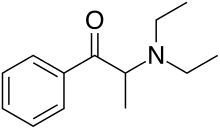Amfepramone
Amfepramone, also known as diethylpropion, is a stimulant drug of the phenethylamine, amphetamine, and cathinone classes that is used as an appetite suppressant.[2][3] It is used in the short-term management of obesity, along with dietary and lifestyle changes.[2] Amfepramone is most closely chemically related to the antidepressant and smoking cessation aid bupropion (previously called amfebutamone), which has also been developed as a weight-loss medicine when in a combination product with naltrexone.[4]
 | |
| Clinical data | |
|---|---|
| Trade names | Tenuate, Tepanil |
| Other names | Diethylpropion |
| AHFS/Drugs.com | Monograph |
| MedlinePlus | a682037 |
| Pregnancy category |
|
| Routes of administration | Oral |
| ATC code | |
| Legal status | |
| Legal status |
|
| Pharmacokinetic data | |
| Elimination half-life | 4-6 hours (metabolites)[1] |
| Excretion | Urine (>75%)[1] |
| Identifiers | |
| |
| CAS Number | |
| PubChem CID | |
| IUPHAR/BPS | |
| DrugBank | |
| ChemSpider | |
| UNII | |
| KEGG | |
| ChEBI | |
| ChEMBL | |
| CompTox Dashboard (EPA) | |
| ECHA InfoCard | 100.001.836 |
| Chemical and physical data | |
| Formula | C13H19NO |
| Molar mass | 205.301 g·mol−1 |
| 3D model (JSmol) | |
| Chirality | Racemic mixture |
| |
| |
| | |
Pharmacology
Amfepramone itself lacks any affinity for the monoamine transporters and instead functions as a prodrug to ethcathinone.[5] Ethcathinone (and therefore amfepramone as well) is a very weak dopaminergic and serotonergic, and is approximately 10x and 20x stronger on norepinephrine in comparison, respectively.[5] As a result, ethcathinone and amfepramone can essentially be considered a member of the class of drugs known as norepinephrine releasing agents (NRAs).
Chemistry
Amfepramone can be synthesized from propiophenone by bromination, followed by reaction with diethylamine.[6][7]
Society and culture
Names
Another medically-utilized name is diethylpropion (BAN and AAN). Chemical names include: α-methyl-β-keto-N,N-diethylphenethylamine, N,N-diethyl-β-ketoamphetamine and N,N-diethylcathinone. Brand names include: Anorex, Linea, Nobesine, Prefamone, Regenon, Tepanil and Tenuate.
Legality
Amfepramone is classified as a Schedule IV controlled substance in the United States. It is also a Schedule IV controlled substance in Canada. In the UK Amfepramone is a class C drug [8] and as a medicine, it is a Schedule 3 Controlled Drug which requires safe custody.
Recreational Use
The authors of several studies of Amfepramone claim that the substance has a relatively low potential for causing addiction in users.[9][10][11][12] However, there have been reports of people using this drug recreationally in the UK . Allegedly, recreational users of Amfepramone in the UK refer to Amfepramone tablets as "tombstones" .
See also
References
- "SPC-DOC_PL 16133-0001" (PDF). Medicines Healthcare products Regulatory Agency. Essential Nutrition Ltd. 18 November 2011. Retrieved 18 July 2014.
- Brayfield A, ed. (30 January 2013). "Diethylpropion Hydrochloride". Martindale: The Complete Drug Reference. London, UK: Pharmaceutical Press. Retrieved 18 July 2014.
- "TGA Approved Terminology for Medicines, Section 1 – Chemical Substances" (PDF). Therapeutic Goods Administration, Department of Health and Ageing, Australian Government. July 1999: 42. Cite journal requires
|journal=(help) - Arias HR, Santamaría A, Ali SF (2009). "Pharmacological and neurotoxicological actions mediated by bupropion and diethylpropion". International Review of Neurobiology. International Review of Neurobiology. 88: 223–55. doi:10.1016/S0074-7742(09)88009-4. ISBN 9780123745040. PMID 19897080.
- Rothman RB, Baumann MH (2006). "Therapeutic potential of monoamine transporter substrates". Current Topics in Medicinal Chemistry. 6 (17): 1845–59. doi:10.2174/156802606778249766. PMID 17017961.
- US patent 3001910, Schutte J, "Anorexigenic Propiophenones", issued 1961-09-26, assigned to Temmler-Werke
- Hyde JF, Browning E, Adams R (1928). "Synthetic Homologs of d,l-Ephedrine". Journal of the American Chemical Society. 50 (8): 2287–2292. doi:10.1021/ja01395a032.
- "Class C Drugs". Schedule 2 Controlled Drugs. UK Legislation.
- Cohen S (1977). "Diethylpropion (tenuate): an infrequently abused anorectic". Psychosomatics. 18 (1): 28–33. doi:10.1016/S0033-3182(77)71101-6. PMID 850721.
- Jasinski DR, Krishnan S (June 2009). "Abuse liability and safety of oral lisdexamfetamine dimesylate in individuals with a history of stimulant abuse". Journal of Psychopharmacology. 23 (4): 419–27. doi:10.1177/0269881109103113. PMID 19329547.
- "Tepanil (diethylpropion hydrochloride) tablet, extended release". Dailymed. National Institutes of Health.
- Caplan J (May 1963). "Habituation to diethylpropion (Tenuate)". Canadian Medical Association Journal. 88: 943–4. PMC 1921278. PMID 14018413.